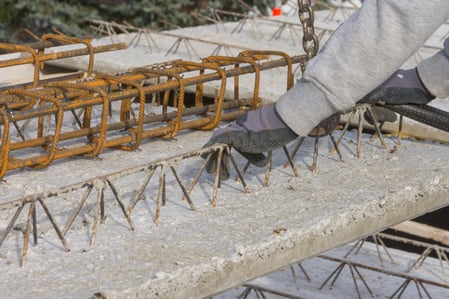Choosing the right winter glove is really more science than anything.

One of the first things to consider when choosing hand protection in the winter months is how well they can tolerate the cold. You’re probably thinking, “how hard could that be? Pick a glove and get back to work”. But before you get too far ahead of yourself, choosing the right glove isn’t as easy as it sounds. Break out your lab coats and pocket protectors, boys and girls. It’s about to get nerdy up in here.
You may think a pair of thick gloves is all you really need when ol’ Jack Frost starts nipping at your nose. Chances are, you’re wrong.
Cold + Wind + Wetness = Trouble
3 Simple Steps to Choosing Winter Work Gloves

1. Choose Gloves that Cover
When the temperatures dip down to temperatures that only Frosty the Snowman could love, your first instinct is to throw on a pair of gloves. But, any old glove? Of course not! Look for gloves that help you do your job, not slow you down. While mittens are proven to keep you warmer (5 people in a tiny closet create more body heat than just 1), they’re probably not the most practical for work.
Choose winter gloves that not only cover your hands, but work with your hands — not against them. Do you need a palm coating for grip when working with small tools? Do you need gloves that are water-resistant? Do you need gloves that allow for dexterity? Think about the work you do and try to match the glove up to those needs.
Not only should you use gloves that work well, you need gloves that fit well. If a glove is too big, it’s harder to use and lets warm air escape. If a glove is too small, it will restrict your movement and leave part of your hand or wrist exposed.
2. Choose Gloves that Insulate

Take a look at your cold weather glove. On the label, you might see a little icon that looks like a shield with a snowflake on it. That little icon is your EN 511 performance rating and can tell you almost everything you need to know about how well your glove will stand up to the cold.
Those 3 numbers after EN 511? Yeah, they tell an important story. Those ratings tell you just how well that glove can protect you from the cold. Plus, in order to earn the hot-to-trot EN 511 status, the glove must also pass the Level 1 EN 388 abrasion test!
a. First number measures Convective Cold (Level 0-4) This is when there’s a transfer of cold through the gloves from the surrounding air to the skin. The higher the number, the more protective warmth factor you get.
b. Second number measures Contact Cold (Level 0-4) Heat transfer happens when glove is in contact with a cold object like tools or climbing ladders. The higher the number, the more insulative factor you get.
c. Third number measures Water Penetration (Level 0 or 1) Any insulation you have is basically useless if it gets wet. “0” indicates there was water penetration after 30 minutes and “1” indicates there was no water penetration after 30 minutes. Basically, it’s a rating that tells you whether water penetrates the glove or not.
There’s a downside to gloves that prevent moisture from penetrating to your skin. They also don’t let sweat out. As you work, you sweat — especially your hands. Fortunately, you can use insulating liners that wick moisture away from your skin. If they get wet, swap them out for fresh ones and get back to work.
3. Choose Gloves that Provide Hazard Protection

Last, but certainly not least, what hazards are you exposed to on a daily basis? You’ll want to be sure that your winter glove offers protection from the dangers you face. Do you work with electrical components, sharp tools or corrosive liquids? Warm hands are nice, but not if they compromise your safety. Make sure your gloves offer protection against the occupational hazards your job exposes you to. These are a just a few types of gloves that you can find:
a. Flame-Resistant Gloves
b. Cut or Puncture-Resistant Gloves
c. Impact/Smash/Contusion- Resistant Gloves
d. Abrasion-Resistant Gloves
d. Vibration-Proof Gloves
Avoid Cold Stress Injury by Choosing Proper Winter Gloves
When your hands are unprotected, exposure to the elements can not only slow you down — but leave you injured.
Fancy words like “vasoconstriction” is your body’s initial reaction to cold exposure and leads to rapid decrease in body temperature. Your hands and feet help regulate your body temperature for optimum performance. Once your body temperature is compromised, you can kiss any productivity you had planned for the day goodbye.
Vasoconstriction impacts your ability to touch (tactile sensitivity), manipulate tools (manual dexterity) and lift big and heavy things (muscle contraction). Working in the cold weather is tough enough. It’s silly to make it harder on yourself with ineffective gear.
Cold hazards like frostbite, hypothermia and low body temperature are just a few things you’ll want to avoid. Frostbite causes a loss of feeling and color in affected areas and can cause permanent damage to nerves and skin tissue. Frostbite can happen very quickly, that’s why it’s important to notice symptoms quickly.
Know these Symptoms of Frostbite:
-
Reduced blood flow
-
Numbness
-
Tingling or stinging
-
Aching
- Bluish or pale waxy skin
Don’t fall victim to Mother Nature’s icy grip. Fight back with gear designed to work as hard as you do. If you have too much on your plate and don’t have the time or energy to figure out what winter gloves you need, just click here for help. The pros at Quad City Safety are here to help you figure it all out.
Safety: It’s Your Life, It’s Our Business








